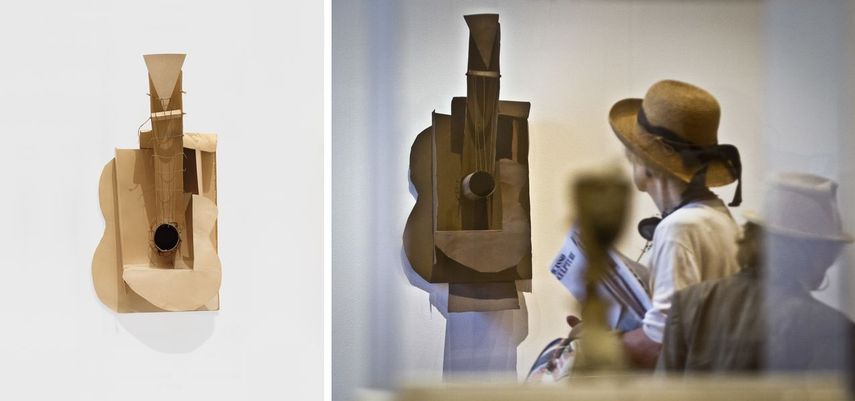
- Picasso maquette for guitar skin#
- Picasso maquette for guitar license#
- Picasso maquette for guitar series#
These lit surfaces become colorful surfaces in the collages. These planes are positioned in such a manner to maximize the reflection of light on certain surfaces, similar to the depicted planes illuminated by light in Analytic Cubist paintings.
Picasso maquette for guitar series#
In his 1909 Head ( Fernande), a bumpy, lumpy contiguous series of planes represent the hair and face of the woman he loved at this time.
Picasso maquette for guitar skin#
Picasso’s Guitar constructions broke with the continuous skin of conventional sculpture. (The museum acquired the “maquette” in 1973, after Picasso’s death, in accordance with his wishes.) At that time, the director of paintings and drawings, William Rubin, believed that the “maquette” (model) cardboard guitar dated to the early part of 1912. Picasso gave his 1914 metal Guitar to the Museum of Modern Art in 1971. New York, New York, The Museum of Modern Art The life of the cafГ© certainly summed up modern Parisian life for the artists – it was where he spent a good deal of time talking with other artists – but the simple array of objects also ensured that questions of symbolism and allusion might be kept under control. During his Analytic Cubist phase Picasso had suppressed color, so as to concentrate more on the forms and volumes of the objects, and this rationale also no doubt guided his preference for still life throughout this phase. This combination of painting and mixed media is an example of the way Picasso “synthesized” color and texture – synthesizing new wholes after mentally dissecting the objects at hand. Picasso’s Bowl of Fruit, Violin and Bottle is typical of his Synthetic Cubism, in which he uses various means – painted dots, silhouettes, grains of sand – to allude to the depicted objects. Although Guernica is undoubtedly modern art’s most famous response to war, critics have been divided on its success as a painting. The minotaur may allude to bull fighting, a favorite national past-time in Spain, though it also had complex personal significance for the artist. Much time has been spent trying to decode the symbolism of the picture, and some believe that the dying horse in the center of the painting alludes to the people of Spain. While it was a sensation at the fair, it was consequently banned from exhibition in Spain until military dictator Francisco Franco fell from power in 1975. Painted in one month – from May to June 1937 – it became the centerpiece of the Spanish pavilion at the Paris World’s Fair later that year. This painting was Picasso’s response to the bombing of the Basque town named Guernica on Apduring the Spanish Civil War. The exhibition is organized by Anne Umland, Curator, with Blair Hartzell, Curatorial Assistant, Department of Painting and Sculpture, The Museum of Modern Art. Bringing together some 70 closely connected collages, constructions, drawings, mixed-media paintings, and photographs assembled from over 30 public and private collections worldwide, this exhibition offers fresh insight into Picasso’s cross-disciplinary process in the years immediately preceding World War I. Picasso: Guitars 1912–1914 explores this breakthrough moment in 20th-century art, and the Guitars’ place within it. These two Guitars, both gifts from the artist to MoMA, bracket an incandescent period of material and structural experimentation in Picasso’s work. In 1914 the artist reiterated his fragile papery construction in a more fixed and durable sheet metal form. Cobbled together from cardboard, paper, string, and wire, materials that he cut, folded, threaded, and glued, Picasso’s silent instrument resembled no sculpture ever seen before.

Sometime between October and December 1912, Pablo Picasso (1881–1973) made a guitar. If you would like to publish text from MoMA’s archival materials, please fill out this permission form and send to. If you would like to reproduce text from a MoMA publication, please email.

For more information about film loans and our Circulating Film and Video Library, please visit. For access to motion picture film stills for research purposes, please contact the Film Study Center at. Motion picture film stills cannot be licensed by MoMA/Scala.
Picasso maquette for guitar license#
All requests to license archival audio or out of copyright film clips should be addressed to Scala Archives at. At this time, MoMA produced video cannot be licensed by MoMA/Scala. MoMA licenses archival audio and select out of copyright film clips from our film collection. If you would like to reproduce an image of a work of art in MoMA’s collection, or an image of a MoMA publication or archival material (including installation views, checklists, and press releases), please contact Art Resource (publication in North America) or Scala Archives (publication in all other geographic locations).


 0 kommentar(er)
0 kommentar(er)
